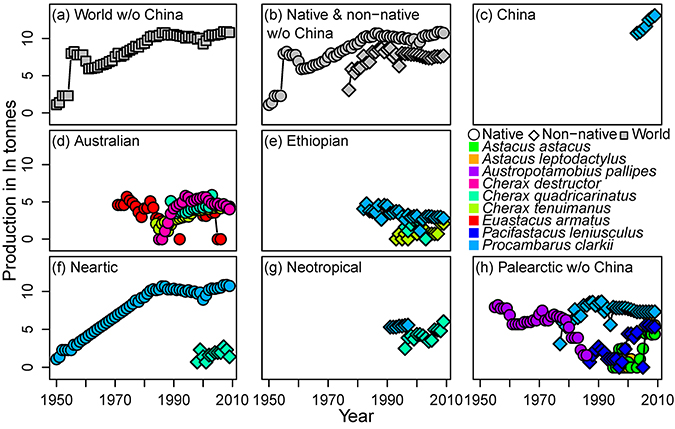
Full text loading...
Impacts of nonindigenous crayfishes on ecosystem services exemplify the mixture of positive and negative effects of intentionally introduced species. Global introductions for aquaculture and ornamental purposes have begun to homogenize naturally disjunct global distributions of crayfish families. Negative impacts include the loss of provisioning (e.g., reductions in edible native species, reproductive interference or hybridization with native crayfishes), regulatory (e.g., lethal disease spread, increased costs to agriculture and water management), supporting (e.g., large changes in ecological communities), and cultural (e.g., loss of festivals celebrating native crayfish) services. Where quantification of impacts exists (e.g., Procambarus clarkii and Pacifastacus leniusculus in Europe), regulations now prohibit introduction and spread of crayfishes, indicating that losses of ecosystem services have outweighed gains. Recent research advances such as predicting invasiveness, predicting spread, improved detection and control, and bioeconomic analysis to increase cost-effectiveness of management could be employed to reduce future losses of ecosystem services.

Article metrics loading...

Full text loading...


Data & Media loading...
Supplemental Material
Download all Supplemental Material as a PDF. Includes: Supplemental Table 1 and literature cited, and Supplemental Figure 1 (also reproduced below) Download Supplemental Table 1 only (excluding references) as an Excel file. Supplemental Figure 1: Global crayfish production by species in logged metric tons for the (a) world total production excluding China, (b) world native and nonindigenous production excluding China, (c) China, (d) Australian realm, (e) Ethiopian realm, (f) Nearctic realm, (g) Neotropical realm, and (h) Palearctic realm. The Oriental realm is excluded due to very low production outside of China, and China is presented separately as is common with FAO fisheries data (FAO, 2010). Data compiled from the FAO Global Production Statistics database (www.fao.org/fishery/statistics/global-production/en, accessed 9 Feb 2012).
